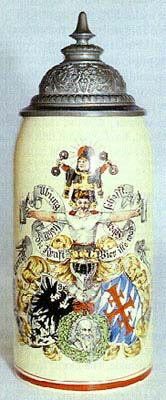
by Jack G. Lowenstein
 |
It was at the beginning of the 19th century that organized athletic programs became popular outside of the military establishment. In 1811, the gymnast Friedrich Ludwig Jahn (1778-1852) organized the first gymnastic clubs, or “Turn Vereine,” as they are known in Germany. These clubs served three purposes — they helped develop strong bodies, they promoted patriotism and they were social clubs for men. As today, there were individual programs to strengthen specific muscles and there were group gymnastics. The high points of the year were the periodic contests with neighborhood athletic clubs and the national competitions — which drew an enormous response and even larger audiences. Valuable prizes were awarded to the winning contestants, to be taken home, to be displayed with great pride and to be bragged about for years to come.
Friedrich Jahn was (and still is) known as “Father Jahn” for having fathered the many athletic clubs and for being like a father to so many young men. But besides all that, he is known as a great German nationalist. He was dismayed by the breakup of Prussia after the Napoleonic Wars in 1806 and fought for the renewal of the German nation. He was elected to the national parliament in Frankfurt in 1848. Jahn also started the “4F” movement as part of his athletic clubs, the four Fs standing for “Frisch, Fromm, Froehlich, Frei,” which translate as “Fresh (in body and soul), Godfearing, happy, free.” The four initials are usually seen grouped together to form a cross-like figure.
Beer drinking appears to have been an adjunct to athletic performance. Athletic motifs and the “4F” symbol can be found on countless steins, leading to the conclusion that a great deal of imbibing must have followed exercise sessions and especially victories over other clubs. Turn Verein members had their own club steins, which were doubtlessly used frequently. Contest victors were often awarded valuable steins as prizes, steins made of silver, pewter, porcelain or stoneware, all suitably inscribed. These became family heirlooms, which is lucky for today’s collectors, since these steins were preserved with pride.
__________
*Reprinted by permission from All About Beer Magazine, Vol. 13, No. 4, September 1992.